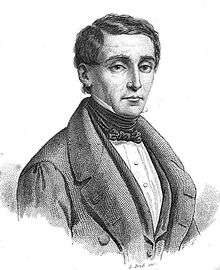Pellegrino Rossi
| Pellegrino Rossi | |
|---|---|
 | |
| 6th Papal Minister of Interior | |
|
In office 10 September 1848 – 15 November 1848 | |
| Monarch | Pope Pius IX |
| Preceded by | Edoardo Fabbri |
| Succeeded by | Carlo Emanuele Muzzarelli |
| Minister of Finance | |
|
In office 16 September 1848 – 15 November 1848 | |
| Monarch | Pope Pius IX |
| Preceded by | Position created |
| Succeeded by | Position abolished |
| Member of the French Chamber of Peers | |
|
In office 1838 – 15 November 1848 | |
| Monarch | Louis Philippe I |
| Personal details | |
| Born |
13 July 1787 Carrara, Tuscany (now Italy) |
| Died |
15 November 1848 (aged 61) Rome, Papal States (now Italy) |
| Resting place | San Lorenzo in Damaso, Rome |
| Nationality |
Tuscan Italian French |
| Political party |
Orléanist (1836–1848) Moderates (Cooperated) (1848) |
| Alma mater |
University of Pisa University of Bologna |
| Profession | Teacher, economist, diplomat |
| Military service | |
| Service/branch |
|
| Years of service | 1815 |
| Rank | Soldier |
| Battles/wars | |
Pellegrino Rossi (13 July 1787 – 15 November 1848) was an Italian economist, politician and jurist. He was an important figure of the July Monarchy in France, and the Minister of Justice in the government of the Papal States, under Pope Pius IX.
Biography
Rossi was born in Carrara, then under the Duchy of Massa and Carrara. Educated at the University of Pisa and the University of Bologna, he became professor of law at the latter in 1812. In 1815 he gave his support to Joachim Murat and his Neapolitan anti-Austrian expedition: after the latter's fall, he escaped to France, and then proceeded to Geneva, where he began teaching a course of jurisprudence applied to Roman law, the success of which gained him the unusual honour of naturalization as a citizen of Geneva. In 1820 he was elected as a deputy to the cantonal council, and was a member of the diet of 1832; Rossi was entrusted with the task of drawing up a revised constitution, which was known as the Pacte Rossi. This was rejected by a majority of the diet, a result which deeply affected Rossi, and made him accept the invitation of François Guizot to settle in France.
Here he was appointed in 1833 to the chair of political economy in the Collège de France, vacated by the death of Jean-Baptiste Say. He was naturalized as a French citizen in 1834, and in the same year became professor of constitutional law in the faculty of law of the Paris University. In 1836 he was elected a member of the Academy of Political and Moral Sciences, was raised to the French peerage in 1839, and in 1843 became dean of the faculty of law.
In 1845 he was sent to Rome by Guizot to discuss the question of the Jesuits, being finally appointed ambassador of France for the Papal States. The revolution of 1848 severed his connection with France, and he remained at Rome and became Minister of the Interior under Pius IX. Rossi's program of liberal reforms, however, never took off. He was also very unpopular owing to his otherwise conservative views.
His assassination took place on the stairs at the opening of the Parliament in the Palazzo della Cancelleria on 15 November 1848 by a stab wound to the neck. This was one of the causes of the flight from Rome of Pope Pius IX and the beginning of the series of events that led to the proclamation of the Roman Republic.
The murderer was said to be Luigi Brunetti, the elder son of Angelo Brunetti (or Ciceruacchio), who acted at the instigation of Pietro Sterbini, and with the cooperation of some veterans or reduci of the conflict in Lombardy. After the murder, the senate adjourned without much sorrow, and little to no attention to the murder victim. That night crowds at the house of Rossi's widow chanted Blessed is the hand that stabbed the Rossi. Sterbini went on to play a prominent role in the Roman Republic in 1849, but fled into exile after its fall, until 1861.[1] In a trial held in 1854, a man by the name of Gabriele Constantini was convicted and executed.
The city of Carrara erected a statue in honour of Pellegrino Rossi.
Selected works
- Cours d'économie politique (1838–54)
- Traité de droit pénal (1829)
- Cours de droit constitutionnel (1866–67)
- Melanges d'économie politique, d'histoire et de philosophie (1857, 2 volumes)
References
- ↑ Garibaldi's Defence of the Roman Republic, (1907) by George Macaulay Trevelyan, 3rd edition, Longmans, Green, and Company, 39 Paternoster Row, London.
 This article incorporates text from a publication now in the public domain: Chisholm, Hugh, ed. (1911). "article name needed". Encyclopædia Britannica (11th ed.). Cambridge University Press.
This article incorporates text from a publication now in the public domain: Chisholm, Hugh, ed. (1911). "article name needed". Encyclopædia Britannica (11th ed.). Cambridge University Press.- Claudio Rendina, Enciclopedia di Roma, Newton Compton, Rome, 1994
- "Pellegrino Rossi". Catholic Encyclopedia.